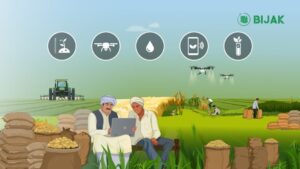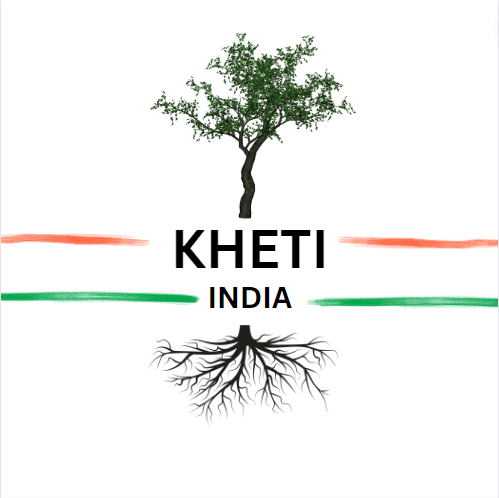
The COVID-19 pandemic has enhanced the use of digital tools and new technologies in various sectors, including agriculture, and thus from there digitalization in agriculture has become a trend and a necessity. Digitalization in Agriculture in India has been used to use the resources efficiently and increase exports to double farmers’ income.
With the disruption caused by the pandemic, the Indian government and different stakeholders in the food production and supply chain have had to adopt digital solutions to maintain continuity. Farmers, input providers, retailers, exporters, and consumers have turned to digital tools as the best alternative to traditional methods. This shift towards digital transformation is helping to keep the agriculture sector functioning smoothly in these unprecedented times.
Digitalization in Agriculture
Digital technologies in agriculture can be broadly categorized into four main areas:
- Data-Driven Agriculture
- Precision Agriculture
- ICT-Enabled Extension
- Digital Financial Services.
-
Data-Driven Agriculture
Data-driven agriculture starts with collecting data from various sources, such as satellite images, soil health information, land records, cropping patterns, market data, and farmer information. This data is crucial for making informed decisions and policies in agriculture and is like a gift to the farmers.
Satellite Data: Satellite images help in land use, land cover classification, and crop characterization.
Drones: Drones provide a cost-effective alternative to high-resolution satellite imagery and are used for mapping and surveying.
Weather Data: Collected through satellites and analyzed to provide real-time weather updates to farmers via digital platforms and smartphones, helping them plan their activities better.
For example, the International Crops Research Institute for the Semi-Arid Tropics (ICRISAT) reported that farmers using Sowing App advisories saw a 30% increase in yield compared to those who did not have timely information.
-
Precision Agriculture
Precision Agriculture aims to enhance production by optimizing resource use for economic and environmental sustainability. By using IoT sensors, drones, AI in Agriculture, and satellites, farmers can make more accurate decisions at the farm level, leading to increased crop yield and efficient resource use.
IoT in Agriculture: IoT-enabled devices monitor and manage resources like water for irrigation. Studies have shown that using IoT in the USA increased per-hectare crop yield by 2% and reduced water requirements by 8%.
-
Digital Agriculture Extension
Digital agriculture extension uses tools like SMS, Interactive Voice Response (IVR), interactive radio, and low-cost video to provide farmers with timely information on best practices, weather forecasts, and alerts. Traditional methods of extension, which involve person-to-person interaction, are costly and time-consuming. Digital methods enhance the reach and effectiveness of extension services.
Digital Extension Services: These services are adaptable to local contexts, demand-driven, market-oriented, and involve multiple actors. They have been shown to increase crop productivity and commercialization while reducing input use.
-
Digital Financial Services
Digital Financial Services have become more accessible in India through the implementation of the JAM trinity—Jan Dhan bank accounts, Aadhaar cards, and mobile phones. These services help in direct benefit transfers, digital headcounts of livestock, and monitoring their health.
PM-KISAN: The Pradhan Mantri Kisan Samman Nidhi scheme transfers funds directly to farmers’ bank accounts, reducing bureaucratic interference.
Crop Insurance: Drones are used to assess crop damage, speeding up and increasing the accuracy of insurance claims.
Food Traceability and Resource Optimization
Digital platforms enable food traceability, providing real-time information about the origin and journey of food products from the farm to the market. This transparency helps build consumer trust and reduces wastage in the supply chain by aligning supply with demand more effectively thus called as Blockchain technology.
For instance, India’s banana value chain saw significant improvements through the integration of digital technologies, leading to reduced wastage and increased farmers income.
Government Initiatives in Digital Agriculture
The Indian government has taken several steps to promote digital agriculture:
India Digital Ecosystem of Agriculture (IDEA): This framework aims to create a federated farmers’ database to build innovative agri-focused solutions.
National e-Governance Plan in Agriculture (NeGP-A): Funds are provided for projects involving modern technologies like AI, machine learning, robotics, drones, data analytics, and blockchain.
National Agriculture Market (e-NAM): An electronic trading portal that connects the Agricultural Produce Market Committee (APMC) mandis across India to create a unified and national market.
PM-KISAN Mobile App: Helps farmers manage their applications and view the status of funds directly on their mobile phones.
Integrated Scheme for Agricultural Marketing (AGMARKNET): Provides agricultural marketing-related information through a single window portal.
Agriculture Infrastructure Fund (AIF): Offers financial support for post-harvest management infrastructure and community farming assets.
National Project on Soil Health and Fertility: Issues soil health cards to farmers, enabling them to track soil samples online.
Kisan Suvidha Mobile App: Provides critical information on weather, market prices, plant protection, and more.
Challenges in Digitalizing Agriculture
Despite the numerous benefits, there are several challenges to digitalizing agriculture in India:
Digital Divide: Many small and marginal farmers lack access to smartphones, computers, and reliable internet connectivity. Bridging this digital divide is essential for the widespread adoption of digital technologies.
Digital Literacy: Farmers need to be trained to use digital tools effectively. Many farmers are not familiar with digital platforms and technologies, which can hinder their adoption and thus many farmers hesitate with this creating lower returns on their crops.
Infrastructure: Rural areas often lack the necessary infrastructure, such as internet connectivity and electricity, which are crucial for the functioning of digital tools, and some Indian villages even today do not have such infra to support digitalization in their fields,
Data Privacy and Security: With the collection of large amounts of data, ensuring data privacy and security is critical. Farmers need to trust that their data is being handled securely and ethically.
Cost: The initial investment in digital tools and technologies can be high, which may be a barrier for small and marginal farmers. Providing subsidies or financial assistance could help in overcoming this challenge but still, the cost to implement the technology on their farms is quite high which the majority of the small and marginal farmers can not afford.
Policy and Regulation: There is a need for clear policies and regulations to support the digital transformation of agriculture. This includes data governance, digital infrastructure, and support for innovation.
Integration of Systems: Integrating various digital platforms and systems can be complex. Ensuring interoperability between different technologies and platforms is necessary for seamless functioning.
